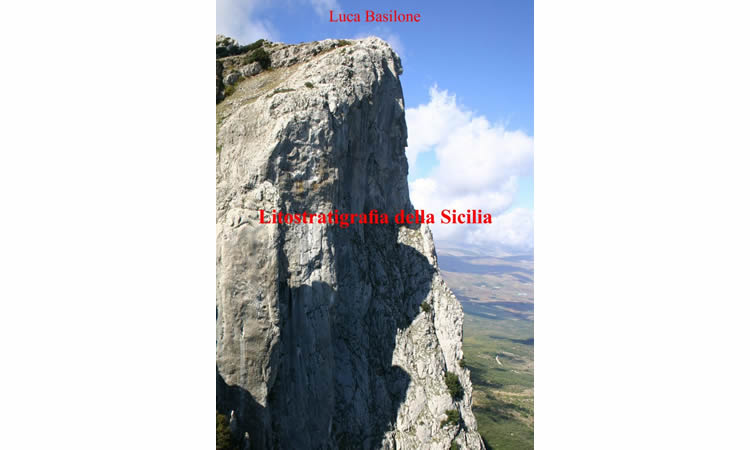Autore: Luca Basilone
Formato: A4
Pagine: 159
Editore: Arti Grafiche Palermitane s.r.l.
Edizione: 2012
The extended, well documented and richly illustrated monograph dedicated to LITHOSTRATRIGRAPHY OF SICILY, written by Luca Basilone from the University of Palermo, deserves a special presentation. It displays the results of over ten years of field work carried out under the expert and careful guidance of Raimondo Catalano and from related detailed sedimentologic, microcropaleontologic and microfacies analysis. The work is pertinent in particular to several geological sheets of the new geologic map at the scale 1:50 000 of the Italian CARG project, but it has a much broader context, that extends well beyond the sheets boundaries.
Indeed, Sicily , the largest island of the Mediterranean is situated just in the middle of this small ocean basin, that is surrounded and crossed by a series of mountain ranges created during the alpine orogeny. In terms of plate tectonics , Sicily is dissected by a W-E directed plate boundary that separates the two major plates Eurasia and Africa, the latter subject to a counterclockwise rotation.
Collisional mountain ranges are developed on the northern border of the island and terminate towards ENE with the Peloritani Mountains (Calabrian arc with a metamorphic basal unit). Westward', the complex chain is SSE vergent and displays a thickness of up to 15 km. Three units are distinguished, as follows: Peloritani units, Sicilidi units, Maghrebian units. The collision is related to the alpine orogeny, and is Paleogene-Miocene in age. The western Mediterranean (remnant of the Mesozoic Tethys) was entirely consumed ("lost ocean") after the alpine orogeny, and the Balearic basin was created by the counterclockwise rotation of the Corsica/Sardinia block. This happened in late Oligocene/early Miocene time. The counterclockwise rotation of the Italian peninsula initiated during the Messinian salinity crisis and is still active to-day.
But well before the conceptual model of plate tectonics was formulated in the late sixties of last century, the rich fossil faunas of various ages attracted the attention of local paleontologists, first of all Gemmellaro (from 1872).
The existence of the highest active volcano in Europe was another strong attraction of Sicily for geologists and volcanologists even in the early days of science. Finally, mining geology with special reference to the exploitation of the Gessoso-solfifera formation played an important role starting from the second half of the eighteenth century (Mottura, 1871, Baldacci, 1886) and, more recently, are documented by the prominent work of Ogniben (1957) and Decima (1975).
Oil exploration started in Sicily during world war two, soon after the american troops desimbarqued near Gela on July 10,1943. Gela proved to be an important oil field, and the influence of Hollis Hedberg, who was vice-chair of Gulf Oil Co. at that time is strongly felt in the modern, practical approach to lithostratigraphy (Schmidt di Friedberg, 1964-65), predating the publication of the International Guide of Stratigraphic Nomenclature. Meanwhile, structural geologists concentrated their efforts in deciphering the northern chains (Broquet, Mascle, Caflisch) where richly fossiliferous Mesozoic successions are exposed and document important facies changes.
A new interest in Sicilian geology derived from the first deep sea exploration of the Mediterranean by the R/V GLOMAR CHALLENGER in 1970 and the unexpected discovery that evaporites quite similar to those outcropping in Sicily (Gessoso-solfifera formation) were present in the subbottom of the Balearic, Thyrrhenian, Ionian and Levantine basin, directly underlying the Trubi formation. As a follow-up of the discovery, a conceptual model for a deep-sea desiccation model was formulated, and the "Messinian salinity crisis" became a major subject of multidisciplinary, interdisciplinary, high resolution multinational researches that greatly contributed to improve the late Neogene stratigraphy notwithstanding the inherent difficulties deriving from the complicated geodynamic situation. Indeed, the investigations carried out on the outcrops bordering the Sicily channel from Capo Bianco through Capo Rossello to Falconara and Gela originated astrocyclostratigraphy (of Hilgen, 1991 and the Utrecht school) and are considered the template for the Pliocene time-scale (MB. Cita and colleagues). But some aspects of the model (s) are still controversial, after over forty years and over 1000 publications, as the role and precise location of the sills separating the various subbasins, the timing of the desiccation phase, the speed of the final filling, the source of the "lago mare".
In the Monograph compiled by Luca Basilone 62 formations are described, of which 43 have already been formalized.
Ten are emended in the present paper, and ten more are proposed as new. The seven sinthems follow the usage adopted by CARG for the sediments that represent the youngest deposits that cover the substrate, are non marine in origin, are usually unfossiliferous and thus difficult to date (as alluvial fan, beach rock, cemented debris, eluvial deposits). Sinthems in principle should be bounded by erosional surfaces of regional significance.
The lithostratigraphy of the Sicilian rocks described by Luca Basilone is based on outcrops and also on subsurface data derived by borehole stratigraphy calibrated by the interpretation of seismic reflection profiles.
The Monograph is open to new and future integrations useful to improve our knowledge of the Sicilian geology.
MARIABIANCA CITA
Professore emerito in Geologia, Università Statale di Milano
Presidente della Commissione Italiana di Stratigrafia (CIS)

